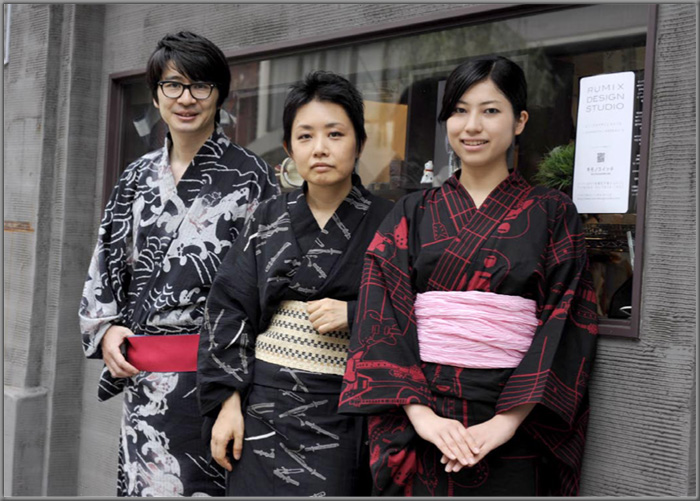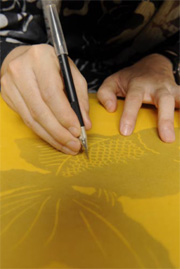Home > Highlighting JAPAN > Highlighting Japan AUGUST 2011 > Timeless Appeal of the Yukata
Highlighting JAPAN
COVER STORY: The Colors of Cool
Rumi Shibasaki (center) and colleagues model yukata in the Rumix line, featuring (from left) a classic wave design, swords, and electric guitars.
Credit: YOSHIFUSA HASHIZUME
Timeless Appeal of the Yukata

A Rumix designer cuts a goldfish pattern to be used for dying yukata fabric.
Credit: YOSHIFUSA HASHIZUME
Regular yukata motifs used to include such designs as white patterns on a navy background. In recent years, however, numerous fashion brands have started selling more colorful yukata, which have been especially popular with younger generations. Especially noteworthy is kimono textile designer Rumi Shibasaki, whose novel yukata designs featuring animation characters such as the “Neon Genesis Evangelion” TV series, skulls, the Virgin Mary, and other such images have garnered attention.
After graduating from a fashion school, Shibasaki started her career as a designer of kimono robes and accessories, establishing her Rumix Design Studio in 1994. She has created many yukata designs for top-ranking fashion brands. At the same time, she has launched Rumi Rock, her own brand of novel yukata designs, which has earned her many fans.
“The yukata designs for the Rumi Rock brand are based on Edo (former Tokyo) motifs. The mind-set to pursue something fun and exciting is regarded as something to be cherished. The basic elements of my design drawings are lines and rhythm, stemming from the cultures of ukiyo-e woodblock prints and today’s manga cartoons.”
Shibasaki has received orders from abroad, including a request to incorporate the ukiyo-e works of Utagawa Kuniyoshi into the yukata design.
More than a few Rumi Rock fans routinely wear yukata robes and kimono on holidays.
“It feels nice to change into a yukata when you are off duty. You can relax when you’re wearing one, allowing you to make the most of your leisure time,” notes Shibasaki.
© 2009 Cabinet Office, Government of Japan






